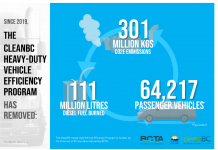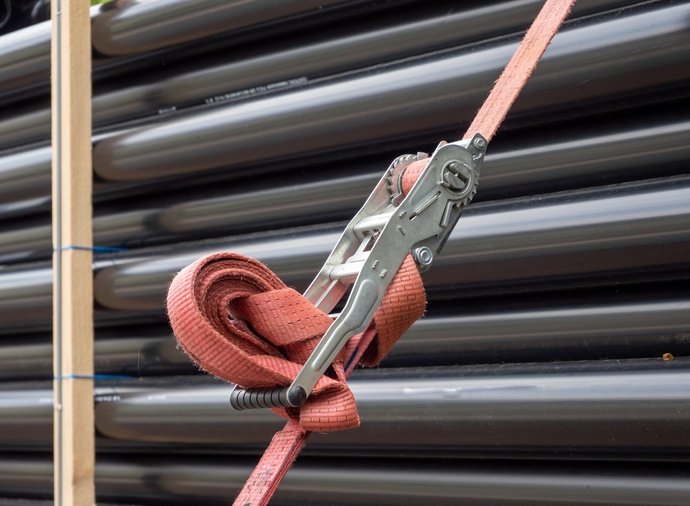When thinking about load securement, everyone immediately thinks about open deck trailers. Flat decks, step decks, floats, goose necks, etc., but improperly secured loads in and on any type of trailer can create a serious safety hazard. Checking load securement on an open deck, untarpped load is pretty simple, as everything is in the open for inspection. A tarpped open deck is still fairly easy to inspect, but a van type trailer is far more difficult to inspect for load securement. For the purposes of this article, we’ll be dealing mainly with load securement in van type trailers.
So. What exactly is load securement? In simple terms, if any object in the trailer can move while the vehicle is in normal motion, then the load is insecure. Under ideal driving conditions, even an insecure load with not move very much. For the sake of argument, we’ll assume you have 36,000 lbs of lead bricks down the centre of a van trailer. If you’re driving at 100 km/h, then the lead bricks are also travelling at 100 km/h, in adherence to Newton’s First Law of Motion: “An object will not change its motion unless a force acts on it.”. .When you turn, accelerate, or brake, then we have to deal with Newton’s Third Law of Motion: “For every action there is an equal and opposite reaction”. Simply put, until you change directions or speed, whatever is in the trailer is not going to move very much. As soon as you accelerate, the granite block will want to move towards the rear of the trailer. If you brake, it will want to move forward. If you turn to the right, it will want to move to the left, and if you turn left, it will want to move to the right. If the lead brick are not properly secured, they can very easily shift from side to side and throw your centre of gravity off to the point of causing a roll over. In the case of a hard braking, they could all shift forward, and break through the front of the trailer. For this reason, the lead bricks must be adequately secured to prevent movement. So how do you secure 12 lead bricks weighing 3,000 lbs each? There are a few ways, and you can use multiple methods. The minimum force requirements for load securement are that the securement must be capable withstanding 80% deceleration in a forward direction, 50% in a rearward and lateral (side to side) direction.
In simple terms, whatever securement devices you use must have a holding capability of 80% of the load’s mass (in this case 28,800 lbs) in the forward direction and 18,000 in all other directions. To secure this particular load, the best case scenario is to block it in front with 2X4s nailed to the floor from the front bulkhead to the front end of the first lead brick. Be sure the 2X4s completely brace the front of the lead bricks, or you risk having the bricks twist and bypass the bracing. You will also need 2X4s nailed to the floor down bother sides of the bricks, and at lease one across the back as well.
For general cargo, say a trailer load of groceries, shrink wrap on the pallets is generally sufficient, as the first 2 or 4 pallets are butted up again the front wall of the trailer, which will fulfill the 80% holding capacity. With all the other pallet stacks butted up against the stack in front of it, that also satisfies the 80%. The walls of the trailer have the 50% requirement covered, so a simple load bar across the rear will suffice, as there is very little chance of anything sliding back during transport. Natural movement will try and move it forward, if anything.
Dangerous Goods (known in the US as “HazMat”) in a van trailer MUST be properly secured, and if you roll across a scale with Dangerous Goods placards on the trailer, you stand a pretty good chance of being called in for an inspection. More than a few times I’ve been subjected to a dangerous goods load securement inspection. The methods for securing Dangerous Goods in a trailer are as numerous as the types of Dangerous Goods, and the number of Dangerous Goods containment methods. Care must also be taken in consideration to the class of Dangerous Goods, the containment method used, and what you are going to secure it with. For example, if your load contains 45 gallon steel drums of paint, you do NOT want to be using load bars! Metal bars rubbing against a steel drum containing a flammable liquid is NOT a good idea. You can use anti-skid mats under the drums (they are a recognized method of securement, as the resist movement). The drums on the very rear of the load must be properly secured from movement in all directions. In addition to the anti skid mats, you can use a load bar, providing you use a non metal, flame resistant buffer between the load bar and the drums. Personally, I’d try to have the drums loaded anywhere but on the very back, as freight loaded behind the Dangerous Goods will act as load securement Some trailers are equipped with tracks along the side to accommodate load straps. If you’re using these load straps, ensure the ratchet handle is well clear of the drums, or is somehow protected from rubbing against the drums.
In addition to Dangerous Goods, produce loads definitely need to be properly secured while in transit! If you’ve never hauled a produce load, consider yourself lucky. They are very tricky to secure, as they are extremely sensitive, and very prone to damage. Load bars and/or load straps are a definite must! To be on the safe side, use 2 load bars or straps from side to side in the trailer, one about 2 feet from the floor, and the other about 5 feet from the floor, and use 2 more load bars from floor to ceiling in the centre of each pallet stack to help hold everything in place. The trailer will flex somewhat as you drive, and the sideways load bars could fall off, and you could have a huge mess in the trailer, as well as a huge cargo claim. In some cases, for example tomatoes, the claim for damages could exceed the revenue for the entire load. I know, I made this mistake once. I pulled a load of tomatoes from Nogales, AZ to Toronto. The 2 load bars across the back of the trailer fell off, and 4 skids of tomatoes ended up on the floor of the trailer, before being simply thrown out. I was told the damage claim from $1,000 more than the revenue for the load.






















